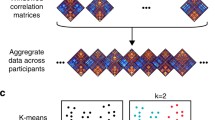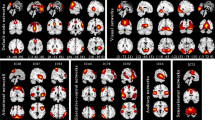Abstract
Schizophrenia is a severe psychiatric disorder associated with altered connectivity of brain functional networks (BFNs). Researchers have observed a profound disruption in prefrontal–temporal interactions, damage to hub regions in brain networks and modified topological organization of BFNs in schizophrenia (SCZ) individuals. Assessment of BFNs with dynamic approaches allow the characterization of new functional structures, such as topological stability patterns and temporal connectivity, which are not accessible through static methods. In this perspective, the present study investigated the physiological processes of brain connectivity in SCZ. A resting-state EEG dataset of 14 SCZ individuals and 14 healthy controls (HC) was obtained at a sampling rate of 250 Hz. Dynamic BFNs were constructed using time-varying graphs combined with the motifs' synchronization method and the indexes were evaluated in different scales: global averages, by hemispheres, by regions, and by electrodes for both groups. The SCZ group exhibited lower temporal connectivity, lesser hub probability, and fewer number of edges in right and left temporal lobes over time, besides increased temporal connectivity in the central-parietal region. Neither differences for the full synchronization time of BFNs were observed, nor for intra- and inter-hemispheric connections between groups. These results indicate that SCZ BFNs exhibit a dynamic fluctuation pattern with abrupt increases in connectivity over time for the regions studied. This elucidates an attempted interaction of the temporal area with other regions (frontal, central-parietal, and occipital) that is not sufficient to maintain a connectivity pattern in schizophrenia individuals similar to that of healthy subjects. Our results suggest that changes in interaction of dynamic BFNs connections in SCZ can be better approached by dynamic analyses that enable a thorough glance at brain changes over time.




Similar content being viewed by others
Availability of data and materials
The dataset used in this study is available in Olejarczyk E, Jernajczyk W (2017) “EEG in schizophrenia”, RepOD, V1. https://doi.org/10.18150/repod.0107441.
References
Akbari H, Ghofrani S, Zakalvand P, Sadiq MT (2021) Schizophrenia recognition based on the phase space dynamic of EEG signals and graphical features. Biomed Signal Process Control 69:102917. https://doi.org/10.1016/j.bspc.2021.102917
Allen P, Moore H, Corcoran CM, Gilleen J, Kozhuharova P, Reichenberg A, Malaspina D (2019) Emerging temporal lobe dysfunction in people at clinical high risk for psychosis. Front Psychiatry 10:298. https://doi.org/10.3389/fpsyt.2019.00298
American Psychiatric Association (2013) Diagnostic and statistical manual of mental disorders: DSM-5. American Psychiatric Association, Washington, DC
Arnold SE (1997) The medial temporal lobe in schizophrenia. J Neuropsy Clin Neurosci 9:460–470. https://doi.org/10.1176/jnp.9.3.460
Begić D, Hotujac L, Jokić-Begić N (2000) Quantitative EEG in schizophrenic patients before and during pharmacotherapy. Neuropsychobiology 41:166–170. https://doi.org/10.1159/000026650
Bellani M, Ferro A, Brambilla P (2010) The potential role of the parietal lobe in schizophrenia. Epidemiol Psichiatr Soc 19:118–119. https://doi.org/10.1017/S1121189X00000816
Berron D, van Westen D, Ossenkoppele R, Strandberg O, Hansson O (2020) Medial temporal lobe connectivity and its associations with cognition in early Alzheimer’s disease. Brain 143:1233–1248. https://doi.org/10.1093/brain/awaa068
Catani M (2019) The anatomy of the human frontal lobe. Handb Clin Neurol 163:95–122. https://doi.org/10.1016/B978-0-12-804281-6.00006-9
Cea-Cañas B, Gomez-Pilar J, Núñez P, Rodríguez-Vázquez E, de Uribe N, Díez Á, Pérez-Escudero A, Molina V (2020) Connectivity strength of the EEG functional network in schizophrenia and bipolar disorder. Prog Neuropsychopharmacol Biol Psychiatry 98:109801. https://doi.org/10.1016/j.pnpbp.2019.109801
Chauvière L (2020) Potential causes of cognitive alterations in temporal lobe epilepsy. Behav Brain Res 378:112310. https://doi.org/10.1016/j.bbr.2019.112310
Chieffi S, Ilardi CR, Iavarone A (2018) Parietal lobe dysfunction in schizophrenia: A review. Curr Psychiatry Rev 14:71–83. https://doi.org/10.2174/1573400514666180703150804
Cobia DJ, Smith MJ, Wang L, Csernansky JG (2012) Longitudinal progression of frontal and temporal lobe changes in schizophrenia. Schizophr Res 139:1–6. https://doi.org/10.1016/j.schres.2012.05.002
Das TK, Kumar J, Francis S, Liddle PF, Palaniyappan L (2020) Parietal lobe and disorganisation syndrome in schizophrenia and psychotic bipolar disorder: A bimodal connectivity study. Psychiatry Res Neuroimaging 303:111139. https://doi.org/10.1016/j.pscychresns.2020.111139
Friston KJ, Frith CD (1995) Schizophrenia: a disconnection syndrome? Clin Neurosci 3(2):89–97
Gallinat J, Mulert C, Bajbouj M, Herrmann WM, Schunter J, Senkowski D, Moukhtieva R, Kronfeldt D, Winterer G (2002) Frontal and temporal dysfunction of auditory stimulus processing in schizophrenia. Neuroimage 17:110–127. https://doi.org/10.1006/nimg.2002.1213
Jin SH, Ham BJ, Kim SY (2005) Functional clustering in EEG photic and auditory driving in schizophrenia. Int J Psychophysiol 56:249–259. https://doi.org/10.1016/j.ijpsycho.2004.12.009
Kaur A, Basavanagowda DM, Rathod B, Mishra N, Fuad S, Nosher S, Alrashid ZA, Mohan D, Heindl SE (2020) Structural and functional alterations of the temporal lobe in Schizophrenia: a literature review. Cureus 12:e11177. https://doi.org/10.7759/cureus.11177
Lacruz ME, García Seoane JJ, Valentin A, Selway R, Alarcón G (2007) Frontal and temporal functional connections of the living human brain. Eur J Neurosci 26:1357–1370. https://doi.org/10.1111/j.1460-9568.2007.05730.x
Mijalkov M, Kakaei E, Pereira JB, Westman E, Volpe G (2017) Alzheimer’s disease neuroimaging initiative BRAPH: A graph theory software for the analysis of brain connectivity. PLoS ONE 12(8):e0178798. https://doi.org/10.1371/journal.pone.0178798
Mubarik A, Tohid H (2016) Frontal lobe alterations in schizophrenia: a review. Trends Psychiatry Psychother 38:198–206. https://doi.org/10.1590/2237-6089-2015-0088
Naim-Feil J, Rubinson M, Freche D, Grinshpoon A, Peled A, Moses E, Levit-Binnun N (2018) Altered brain network dynamics in schizophrenia: a cognitive electroencephalography Study. Biol Psychiatry Cogn Neurosci Neuroimaging 3:88–98. https://doi.org/10.1016/j.bpsc.2017.03.017
Olejarczyk E, Jernajczyk W (2017a) EEG in schizophrenia. RepOD. https://doi.org/10.18150/repod.0107441
Olejarczyk E, Jernajczyk W (2017b) Graph-based analysis of brain connectivity in schizophrenia. PLoS ONE 12:e0188629. https://doi.org/10.1371/journal.pone.0188629
Patel A, Biso GMNR, Fowler JB (2022) Neuroanatomy, Temporal Lobe, in: StatPearls. StatPearls Publishing, Treasure Island (FL).
Ramezani M, Johnsrude I, Rasoulian A, Bosma R, Tong R, Hollenstein T, Harkness K, Abolmaesumi P (2014) Temporal-lobe morphology differs between healthy adolescents and those with early-onset of depression. Neuroimage Clin 6:145–155. https://doi.org/10.1016/j.nicl.2014.08.007
Rikandi E, Mäntylä T, Lindgren M, Kieseppä T, Suvisaari J, Raij TT (2022) Functional network connectivity and topology during naturalistic stimulus is altered in first-episode psychosis. Schizophr Res 241:83–91. https://doi.org/10.1016/j.schres.2022.01.006
Rosário R, Cardoso P, Muñoz M, Montoya P, Miranda J (2015) Motif-Synchronization: A new method for analysis of dynamic brain networks with EEG. Physica A 439:7–19. https://doi.org/10.1016/j.physa.2015.07.018
Rubinov M, Bullmore E (2013) Schizophrenia and abnormal brain network hubs. Dialogues Clin Neurosci 15:339–349. https://doi.org/10.31887/DCNS.2013.15.3/mrubinov
Santana JERS, Baptista AF, Lucena R, da Lopes TS, do Rosário RS, Xavier MR, Fonseca A, Miranda JGV (2021) Altered dynamic brain connectivity in individuals with sickle cell disease and chronic pain secondary to hip osteonecrosis. Clin EEG Neurosci. https://doi.org/10.1177/15500594211054297
Selvaraj S, Arnone D, Cappai A, Howes O (2014) Alterations in the serotonin system in schizophrenia: a systematic review and meta-analysis of postmortem and molecular imaging studies. Neurosci Biobehav Rev 45:233–245. https://doi.org/10.1016/j.neubiorev.2014.06.005
Sheffield JM, Repovs G, Harms MP, Carter CS, Gold JM, MacDonald AW, Ragland JD, Silverstein SM, Godwin D, Barch DM (2016) Evidence for accelerated decline of functional brain network efficiency in schizophrenia. Schizophr Bull 42:753–761. https://doi.org/10.1093/schbul/sbv148
Shenton ME, Kikinis R, Jolesz FA, Pollak SD, LeMay M, Wible CG, Hokama H, Martin J, Metcalf D, Coleman M (1992) Abnormalities of the left temporal lobe and thought disorder in schizophrenia. A quantitative magnetic resonance imaging study. N Engl J Med 327:604–612. https://doi.org/10.1056/NEJM199208273270905
Toutain TG, Baptista AF, Japyassú HF, Rosário RS, Porto JA, Campbell FQ, Miranda JGV (2020) Does meditation lead to a stable mind? Synchronous stability and time-varying graphs in meditators. J Complex Networks 8:cnaa049. https://doi.org/10.1093/comnet/cnaa049
Toutain TGL de O, Alba G, Miranda JGV, do Rosário RS, Muñoz M, de Sena EP (2022) Brain asymmetry in pain affective modulation. Pain Med 23:686–696. https://doi.org/10.1093/pm/pnab232
Van Den Heuvel MP, Fornito A (2014) Brain networks in schizophrenia. Neuropsychol Rev 24:32–48. https://doi.org/10.1007/s11065-014-9248-7
Wang L, Metzak PD, Honer WG, Woodward TS (2010) Impaired efficiency of functional networks underlying episodic memory-for-context in schizophrenia. J Neurosci 30:13171–13179. https://doi.org/10.1523/JNEUROSCI.3514-10.2010
Yildiz M, Borgwardt SJ, Berger GE (2011) Parietal lobes in schizophrenia: do they matter? Schizophr Res Treat 2011:581686. https://doi.org/10.1155/2011/581686
Zhang W, Lei D, Keedy SK, Ivleva EI, Eum S, Yao L, Tamminga CA, Clementz BA, Keshavan MS, Pearlson GD, Gershon ES, Bishop JR, Gong Q, Lui S, Sweeney JA (2020) Brain gray matter network organization in psychotic disorders. Neuropsychopharmacology 45:666–674. https://doi.org/10.1038/s41386-019-0586-2
Acknowledgements
The authors are indebted to the Fundação de Amparo à Pesquisa do Estado da Bahia (FAPESB), for the financial support. We are also thankful to Laboratory of Biosystems from Universidade Federal da Bahia for helping with the software developed for construction of the BFNs.
Funding
This work was supported by Fundação de Amparo à Pesquisa do Estado da Bahia (FAPESB) (Number 307/2020–Cota 2020; BOL0202/2020). The author José Garcia V. Miranda received financial support from the Brazilian National Council for Technical and Scientific Development (CNPq), grant number 307828/2018–2.
Author information
Authors and Affiliations
Contributions
TGLOT was involved in the design and execution of the paper, initiated and performed data processing, applied statistics and wrote the manuscript. RSR, EPS, and JGVM evaluated the statistics and methodology applied in the study. RSR created the motif’s synchronization method applied in this study. JGVM, EPS, and RSR revised the manuscript. All authors read and approved the final manuscript.
Corresponding author
Ethics declarations
Conflict of interest
The authors declare no commercial, financial or any other conflict of interest in this research.
Ethical approval
The original study was approved by Ethics Committee of the Institute of Psychiatry and Neurology in Warsaw, Poland.
Consent to participate
Informed consent was obtained from all individual participants included in the original study.
Additional information
Publisher's Note
Springer Nature remains neutral with regard to jurisdictional claims in published maps and institutional affiliations.
Supplementary Information
Below is the link to the electronic supplementary material.
Rights and permissions
Springer Nature or its licensor (e.g. a society or other partner) holds exclusive rights to this article under a publishing agreement with the author(s) or other rightsholder(s); author self-archiving of the accepted manuscript version of this article is solely governed by the terms of such publishing agreement and applicable law.
About this article
Cite this article
de O. Toutain, T.G.L., Miranda, J.G.V., do Rosário, R.S. et al. Brain instability in dynamic functional connectivity in schizophrenia. J Neural Transm 130, 171–180 (2023). https://doi.org/10.1007/s00702-022-02579-1
Received:
Accepted:
Published:
Issue Date:
DOI: https://doi.org/10.1007/s00702-022-02579-1




